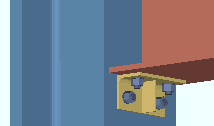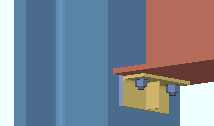The Beam Seat Settings setup window ( Fabricator Settings ) (read-only)
Also see :
- Beam seat input specs (settings for defining beam seats)
- Setup of beam seats (various related setup options)
home > project settings > fabricator > standard fabricator connections > | classic
Method 1 : Home > Project Settings > Fabricator > Standard Fabricator Connections > Beam Seat Settings .
home > project settings > fabricator > standard fabricator connections > | classic | top
------ Settings on this window ------
Standard hole type: Standard round or Short slot or Long slot or Oversized round or User Slot #1 or User Slot #2 .

Effect on a full-featured SDS2 program: The hole type shown here applies (in a full-featured SDS2 program , not in an SDS2 review station ) during Process and Create Solids to the design of beam seats. Connection design in that program will determine the specific size and shape of holes on beam seats based on the hole type shown here and the diameter of the bolt that is used.
Also see: A similar option named " Standard hole type ," which applies to joist seats, can be found on the Joist Connection Settings window.
Member edge distance for seated connection: The distance (in the primary dimension " Units " or in other units ) from the framing edge of the supported beam to the center of the first hole.
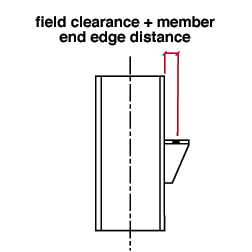
Effect on a full-featured SDS2 program: The member edge distance shown here applies (in a full-featured SDS2 program , not in an SDS2 review station ) to the design of beam seats. Connection design in that program will determine how far from the framing edge of the seat to place the center of the holes by using the member edge distance (shown here) and adding that distance to either the " Beam seats " field clearance or the " Auto standard field clearance ."
Extend seat to column flange if clearance is less than: The distance (in the primary dimension " Units " or in other units ) between the flange of the beam and the flange of the column at which the program will design a beam seat that extends to the column flanges.
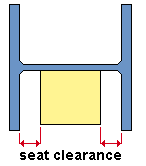
Effect on a full-featured SDS2 program: Normally beam seats are designed in a full-featured SDS2 program to have their edges flush with the edges of the bottom flange of the beam. The distance shown here instructs the program to look at seats into column webs. If the bottom flange of the beam is closer to a column flange than the entered dimension, the program will automatically extend the seat to the column flanges and clip the inside corners using the column's " k distance " to determine the size of the cut.
Also see: A similar option named " Extend seat to column flange if clearance is less than ," which applies to joist seats, can be found on the Joist Connection Settings window.
Angle seat to supporting member: Bolted or Welded . This applies when ' Unstiffened L ' or ' Stiffened L ' is selected as the " Seat material " and ' Automatic ' is selected for " Seat to supporting member " on the Beam Review window or the User Defined Connection window or Auto Standard Connections window.
|
|
' Bolted ' instructs connection design in a full-featured SDS2 program to field bolt the angle seat to the supporting column when ' Automatic ' is selected for " Seat to supporting member ." The angle seat is shop bolted to the beam and is drawn on the beam detail.
' Welded ' instructs the program to weld the angle seat to the column when ' Automatic ' is selected. The seat is drawn on the column detail.
Also see: A similar option named " Angle seat to supporting member ," which applies to joist seats, can be found on the Joist Connection Settings window,.
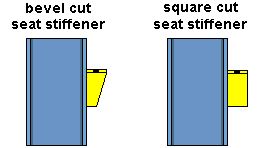
If this box is checked (
), the program square cuts the stiffener on the seated connection.
If the box is not checked (
), the program bevel cuts the stiffener.
Also see: A similar option named " Square cut seat stiffener ," which applies to joist seats, can be found on the Joist Connection Settings window.
home > project settings > fabricator > standard fabricator connections > | classic | top

